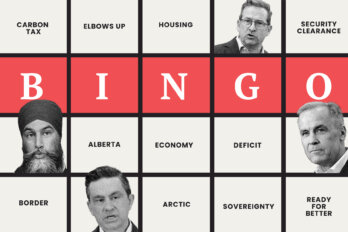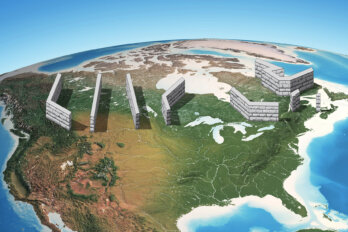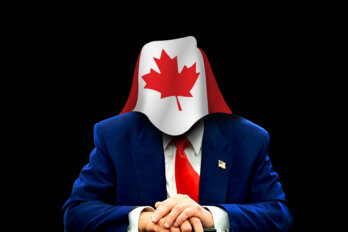A gentle snowfall greeted the dozens who turned up in the Garden of the Provinces and Territories on the morning of December 12, 2024, for the unveiling of Ottawa’s latest monument.
There was scant media presence, perhaps a consequence of the official advisory having gone out just two days earlier. The federal heritage minister, Pascale St-Onge, wasn’t present. A spokesperson later said she was on parental leave. Her replacement, Liberal MP Yvan Baker, was also missing, though no excuse was given. Officially called the “Memorial to the Victims of Communism—Canada, a Land of Refuge,” the monument attracted the active involvement of many prominent Liberals and Conservatives over the last seventeen years, including prime ministers past and present. But no politicians spoke at the dedication.
Addressing the crowd was Ludwik Klimkowski, chair of the charitable group Tribute to Liberty, which led the initial fundraising efforts for the monument. Behind him was the object he had spent years helping to bring to life: two long walls of curving metal frames supporting over 4,000 bronze rods tightly arrayed on 365 slender posts. Each rod is angled to match the sun’s changing position for every hour of every day, with a break in the middle for the winter solstice—the longest night of the year and turning point in the calendar. Representing rebirth, the sculpture paid tribute to Canada’s role in helping victims of communism find freedom and a fresh start.
But one crucial element was missing: the victims. The names meant to be inscribed on the monument’s Wall of Remembrance were conspicuously absent. As Klimkowski delivered his prepared remarks, he concluded by expressing hope that those present would return in 2025 to share in the stories of the individuals who had been intended for commemoration.
As he did so, a lone voice called out: “No Nazis.”
While such a statement might be dismissed as crude heckling, in the case of the memorial, it feels more like a pointed reminder. Canadian Heritage’s doubts about whether all Nazis and fascists had been purged from a list of over 500 proposed “victims of communism” are precisely why the $7.5 million monument remains unfinished.
Already many years behind schedule and several million dollars over budget, the memorial was supposed to have been unveiled in November 2023. The plan was shelved shortly after Parliament celebrated SS volunteer Yaroslav Hunka as a “Canadian and Ukrainian hero” during Ukrainian president Volodymyr Zelenskyy’s state visit in September 2023. The recognition of an individual who swore allegiance to Adolf Hitler during the Second World War reignited interest in the subject of war criminals in Canada. It also seems to have sparked serious concerns within Canadian Heritage about the figures being honoured.
The monument was off limits to the public for over a year while Canadian Heritage reviewed its contents. Internal emails obtained through Access to Information by The Walrus suggest that uncertainty concerning the chief commemorative element, the Wall of Remembrance, lingered for many months. The aggravating problem was a list of names assembled by Tribute to Liberty. A report commissioned by Canadian Heritage called into question more than half of the names, citing the difficulty of verifying the backgrounds of the people involved and their potential connection to the atrocities of the Holocaust. Emails from November 2023 reveal that the National Capital Commission decided to set aside and store the nameplates created prior to Canadian Heritage’s decision to postpone the unveiling.
At every step in its journey, from conception to construction, Ottawa’s Victims of Communism has been beset by controversy. From its location to its design, from who it venerates to the history it obscures, the project is a case study in how not to build monuments.
But the underlying problem is much larger, with roots stretching all the way back to the end of the Second World War and the Canadian government’s controversial decision to welcome Nazi collaborators, SS volunteers, and known war criminals into the country.
The idea to build a monument to victims of communism originated in 2007, when Jason Kenney, then secretary of state for multiculturalism and Canadian identity, accompanied the Czech ambassador through a private park in Scarborough owned by the Czech and Slovak communities. There, Kenney saw the monument Crucified Again, which depicts a tortured man crucified on a hammer and sickle. Kenney, a well-known conservative ideologue and virulent anti-communist, became determined to create a similar public monument in Ottawa.
To shape the project in its early days, Kenney worked with members of communities that had fled communist countries. Many of these non-partisan early members were sidelined and replaced by Conservative Party activists, including former candidates, the Ottawa Citizen reported. Tribute to Liberty—TTL—was formed in August 2008. Though the memorial is now overseen by the government, TTL played a key role in fundraising and developing the monument’s central feature, the Wall of Remembrance.
While the monument’s contents and purpose would eventually become its most controversial aspects, early criticism largely centred on the proposed location and design. From 2010 to 2012, the Stephen Harper administration and the National Capital Commission—NCC, the federal agency managing the capital region—played a game of musical chairs with the memorial, changing its location several times. Finally, it was moved next to the Supreme Court.
The government proposed using an unoccupied plot of land between the court and Library and Archives Canada, but this site had already been set aside for a new justice building for nearly a century. This ultimately led to a court challenge against the NCC by the Royal Architectural Institute of Canada, which argued that the NCC had violated the National Capital Act’s rules prohibiting preparing a site for construction before a monument design had been finalized. According to reporting by the National Post, the NCC had actually been cut out of deliberations almost entirely and had little choice but to approve the Harper government’s backroom decision.
This came to light in August 2013, when Kenney and then immigration minister Chris Alexander announced both the location and that the federal government would contribute $1.5 million to the project. A design competition began shortly thereafter. What was originally supposed to have been an entirely privately funded project was now getting both public money and prime Ottawa real estate to boot. Throughout this time, TTL had been struggling to raise funds, barely able to cover its own operating expenses.
The design competition was held between March and August of 2014, during which time the federal government’s contribution increased to $3 million. When a design was selected that fall, one judge described the submissions as so lacklustre they simply picked the lesser evil. As reported by the Ottawa Citizen, among those involved in choosing the winning concept were Klimkowski (an Ottawa financial planner who became TTL’s board chair in 2012) and journalist David Frum (whose sister, then senator Linda Frum, had made a substantial donation to the project).
By the summer of 2015, the NCC announced the project had been scaled back 20 percent, though it was still controversially located in the judicial precinct. Despite this, costs kept climbing—now $5.5 million—and TTL had fallen well short of the $1.26 million it had pledged to raise. Despite the financial and political support of the Conservative Party, the monument consistently missed its fundraising targets. Canadians were now on the hook for a multi-million-dollar commemorative project dreamt up by Kenney.
In December of 2015, Global News reported that the new Liberal government wouldn’t commit any public funding to the project whatsoever. Two days later, the government clarified that it was in fact capping the public contribution at $1.5 million and that the rest would have to come from private fundraising. It further announced that the monument would once again be relocated, back to a site near the Garden of Provinces and Territories, located along the western edge of Ottawa’s downtown.
The Ottawa Citizen then revealed that the Harper administration had quietly contributed $300,000 to TTL from a program designed to help immigrant communities better integrate into Canadian society. A new design competition was held, this time with public input, and the winning design was announced in May 2017. The monument was supposed to be completed by the end of 2018.
The project then ran into a fundamental question: Who exactly counts as a victim of communism? There’s no shortage of people who suffered persecution under communist regimes. But the lack of a clear definition—something that should’ve been settled long before designs were drafted or locations debated—has come back to haunt the effort. And it’s a question the Canadian government now seems increasingly loath to answer.
Canadian Heritage has consistently attributed delays in the monument’s unveiling to the need to ensure that its commemorative elements align with Canadian values. Yet what those values are in this context has always been vague. This ambiguity reflects a deeper struggle: while the Second World War ended nearly eighty years ago, the fight over how it is remembered persists, with Canada’s confusion in defining the perpetrators clashing against the established historical record.
The Canadian government has, at times, taken the historically inaccurate position that the Nazis and the Soviets were both guilty of committing genocides before and during the Second World War and that both were, in effect, victims of the other. The “double genocide” theory isn’t accepted by mainstream historians, but it lies at the heart of Black Ribbon Day, a commemoration, recognized by Canada, whose origins lie in lobbying efforts by Eastern European ultranationalists to distract from investigations into war criminals permitted into the country.
Roughly 2,000 Ukrainian veterans of the Galicia Division—Hunka’s SS unit—were allowed to immigrate to Canada in 1950, resulting in considerable outrage from Canada’s Jewish community. The Deschênes Commission, the country’s official investigation into the matter in the 1980s, controversially decided that the veterans of the division would not be held collectively responsible for war crimes, even though there already was international legal precedent.
It was during this investigation that Ukrainian nationalists in Canada went on the offensive, claiming they, too, had been the victims of a Holocaust-like atrocity, dubbed the Holodomor, which was a famine directed at the Soviet Union’s Ukrainian population. Whether the Holodomor was an intentional act of genocide is a matter of some scholarly debate. Whether the Holodomor was a genocide comparable to the Holocaust is not—the latter is in a league of its own.
The pushback against war-crimes investigations, however, created a unique context that put atrocities suffered by Jews and by Ukrainians into equal categories. This allowed people who took up arms in support of the Nazis when they rampaged across Eastern Europe in the early 1940s to justify their actions by saying they were fighting communists.
It is no surprise that, as I reported in 2021 for the CBC, known fascists and Nazis were among the people slated for commemoration on the Wall of Remembrance. TTL ran a virtual “buy a brick” fundraising campaign called Pathway to Liberty, with bricks that could be dedicated to alleged victims of communism. Some donors, however, attempted to biographically whitewash the records of sponsored individuals. One brick was purchased for a high-ranking official in a Nazi puppet regime whom donors described as a “poet.”
TTL’s plan was to compile a final list of 1,000 individuals, each symbolically representing 100,000 more. This would add up to a total of 100 million victims, a figure drawn from the controversial Black Book of Communism, a 1997 publication that attempted to tally the death toll attributed to communism. (The book was so thoroughly disputed that some of its own contributors denounced it, and it has since been debunked.) In order to reach that body count, however, every Nazi killed in the Second World War would have to be considered a victim of communism.
It is unclear if TTL vetted the names proposed for commemoration before handing the project over to the federal government in 2020. Records obtained by the Ottawa Citizen show that Canadian Heritage flagged fifty to sixty possible SS volunteers and Nazi collaborators on the list. Two historians, consulted on over 500 entries, recommended a thorough review, a process that would demand significant time and resources. Emails obtained by The Walrus reveal that historian Alti Rodal, an expert on war criminals, who wrote a report for the Deschênes Commission, was also asked to examine the submissions.
Hunka’s name does not appear to have been included among those to be recognized, but others on the list warranted far greater scrutiny. Among them was Ante Pavelic, leader of the Croatian fascist Ustaše regime, and Roman Shukhevych, a Ukrainian collaborator who led ethnic cleansing campaigns.
For all its grand ambitions, the memorial lands as an overpriced blunder—one that skews historical truths and offers little in the way of insight or meaningful conversation. Solstice, the symbolic divide at the heart of its design, might just as easily signify a plunge from light into darkness.




